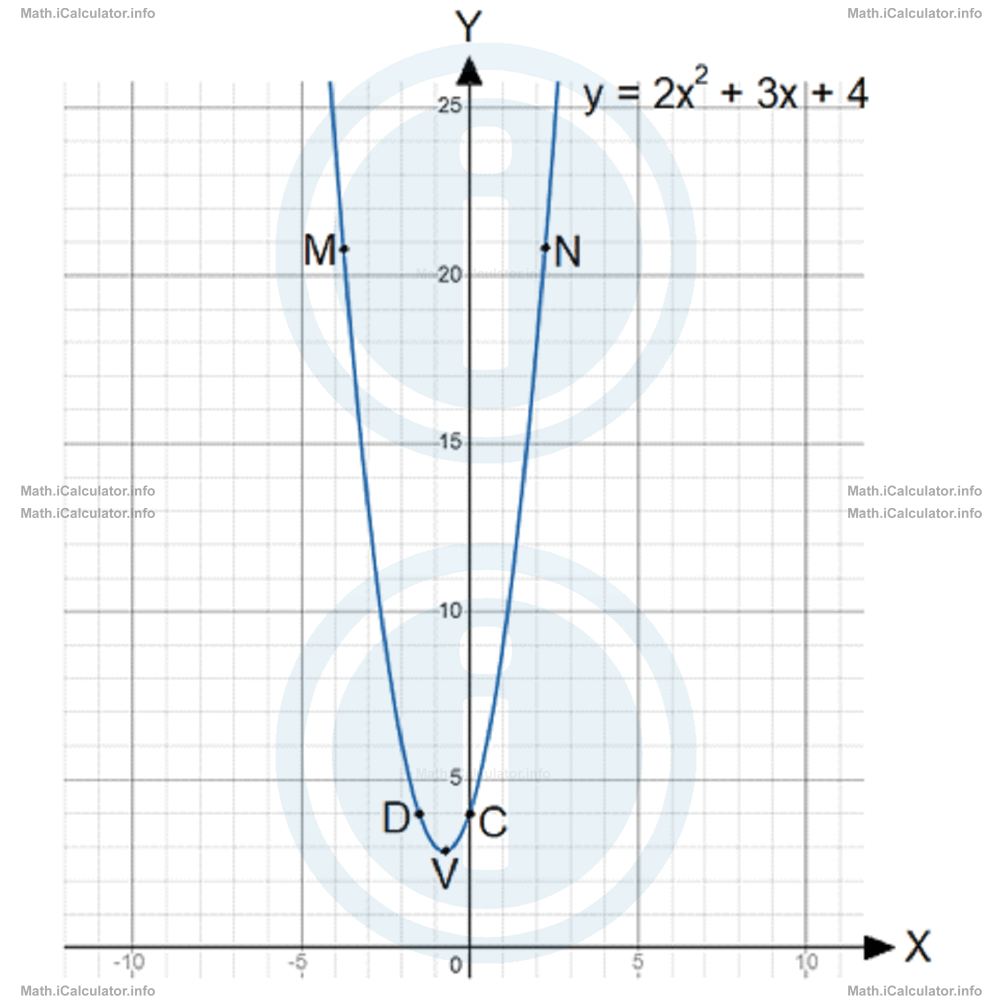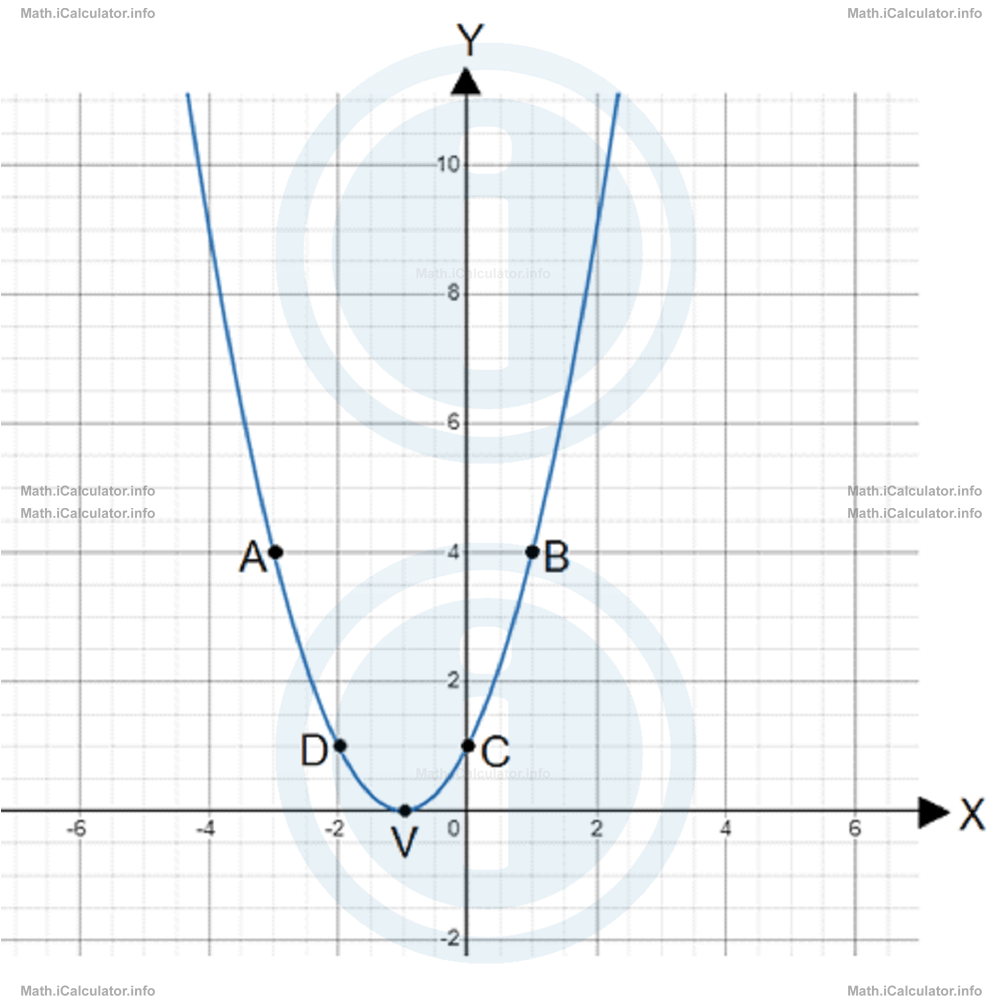Menu
Math Lesson 15.1.4 - What if the Discriminant is Zero or Negative?
Please provide a rating, it takes seconds and helps us to keep this resource free for all to use
Welcome to our Math lesson on What if the Discriminant is Zero or Negative?, this is the fourth lesson of our suite of math lessons covering the topic of Quadratic Graphs Part One, you can find links to the other lessons within this tutorial and access additional Math learning resources below this lesson.
What if the Discriminant is Zero or Negative?
Well, in these cases, we can't make use of points A and B as when the denominator is zero the graph touches the horizontal axis at a single point, which corresponds to the vertex V, while, when the discriminant is negative, the graph does not touch the horizontal axis at all, so there are no x-intercepts.
So what do we do when this occurs? First, we don't panic or worry; despite the fact that you can only find the vertex V from the above points, you still can pick some values for x that are close to the x-coordinate of the vertex, on both sides with the same horizontal distance from the vertex. Another point that is worth including in the list is the y-intercept, as well as its symmetrical analogue point on the other side of the axis of symmetry. In this way, you again have five points, which are more than enough to plot a quadratic graph because they are not random points as they produce a kind of symmetry. Let's consider an example to clarify this point.
Example 2
Plot the graph of the quadratic equation
Solution 2
We have a = 2, b = 3 and c = 4. The discriminant Δ is
= 32 - 4 ∙ 2 ∙ 4
= 9 - 32
= -23
Since the discriminant is negative, the equation 2x2 + 3x + 4 = 0 has no roots. This means there are no x-intercepts in the graph.
The x-coordinate of the vertex V is
= -3/2 ∙ 2
= -3/4
It is not possible to find the y-coordinate using the formula of the vertex, as it involves the discriminant. However, there is another way to find this coordinate, i.e. by substituting this value of xV in the original equation. This yields
= 2 ∙ (9/16) + 3 ∙ (-3/4) + 4
= 18/16 - 9/4 + 4
= 9/8 - 18/8 + 32/8
= 23/8
Hence, the vertex has the coordinates V(-3/4, 23/8).
The y-intercept is another point we can find. Thus, for x = 0, we have y = 4. Therefore, C(0, 4) is intercept point with the graph.
Now, let's find the symmetrical point D to the y-intercept. From the half-segment formula for the x-direction, we have
Substituting the known values, we obtain for xC:
Thus,
The y-coordinate of point D therefore is
= 2 ∙ (9/4) + 3 ∙ (-3/2) + 4
= 18/4 - 9/2 + 4
= 9/2 - 9/2 + 8/2
= 4
Hence, the point D is at (-3/2, 4).
(We could have used the symmetry reasoning when finding the y-coordinate of point C, given that it is at the same quote as D, which means both points have the same y-coordinate.)
To make the graph more accurate, we can find other two points aside C and D that have the same distance from the vertex V. Let's call them for example points M and N. Taking, say, a distance of 3 units away from point V, we have to find two points
= -3/4 - 3
= -3/4 - 12/4
= -15/4
and
= -3/4 + 3
= -3/4 + 12/4
= 9/4
The corresponding y-values for these two points are
= 2 ∙ (225/16) + 3 ∙ (-15/4) + 4
= 225/8 - 45/4 + 4
= 225/8 - 90/8 + 32/8
= 167/8
and
= 2 ∙ (81/16) + 3 ∙ (9/4) + 4
= 81/8 + 27/4 + 4
= 81/8 + 54/8 + 32/8
= 167/8
(as expected).
Thus, the coordinates of points M and N are: M(-15/4, -167/8) and N(9/4, 167/8).
Inserting these five points: V(-3/4, 23/8), C(0, 4), D(-3/2, 4), M(-15/4, 167/8 and N(9/4, -167/8) in the coordinates system and connecting them smoothly yields the following graph:

Now, let's consider another example where the discriminant is zero to see how you can sketch the graph.
Example 3
Plot the graph of the following quadratic equation
Solution 3
We have a = 1, b = 2 and c = 1. The discriminant Δ is
= 22 - 4 ∙ 1 ∙ 1
= 4 - 4
= 0
Thus, there is a single point where the graph touches the horizontal axis, and this point is at the vertex V. Its horizontal coordinate is
= -2/2 ∙ 1
= -2/2
= -1
and the corresponding y-coordinate is
because the vertex is at the only x-intercept available. Thus, the vertex is at V(-1, 0).
Now, let's find the position of the y-intercept of the parabola. Thus, for x = 0 we have y = 1, so the point C where the graph intercepts the y-axis is at C(0, 1).
The symmetrical point to C in respect to the vertical line drawn from the vertex is calculated by using the midpoint formula for the x-direction, i.e.
-1 = 0 + xD/2
xD = 2 ∙ (-1)
xD = -2
The corresponding y-coordinate of point D is the same as that of point C, i.e. yD = 1. Hence, we have D(-2, 1).
Last, we can take other two points on either side of the vertex, at the same distance from it. For example, let's call them A and B where the x-coordinates of these points are two units away from the x-coordinate of the vertex. Thus,
= -1 - 2
= -3
and
= -1 + 2
= 1
The corresponding y-coordinates for these two points are
= (-3)2 + 2 ∙ (-3) + 1
= 9 - 6 + 1
= 4
The same value must have the y-coordinate of point B as well. Let's prove this. We have
= 12 + 2 ∙ 1 + 1
= 1 + 2 + 1
= 4
Hence, we have A(-3, 4) and B(1, 4).
Inserting all these five points, A(-3, 4), B(1, 4), C(0, 1), D(-2, 1) and V(-1, 0) in the coordinates system and connecting them smoothly yields the following figure:

You have reached the end of Math lesson 15.1.4 What if the Discriminant is Zero or Negative?. There are 6 lessons in this physics tutorial covering Quadratic Graphs Part One, you can access all the lessons from this tutorial below.
More Quadratic Graphs Part One Lessons and Learning Resources
Whats next?
Enjoy the "What if the Discriminant is Zero or Negative?" math lesson? People who liked the "Quadratic Graphs Part One lesson found the following resources useful:
- Discriminant Feedback. Helps other - Leave a rating for this discriminant (see below)
- Types of Graphs Math tutorial: Quadratic Graphs Part One. Read the Quadratic Graphs Part One math tutorial and build your math knowledge of Types of Graphs
- Types of Graphs Revision Notes: Quadratic Graphs Part One. Print the notes so you can revise the key points covered in the math tutorial for Quadratic Graphs Part One
- Types of Graphs Practice Questions: Quadratic Graphs Part One. Test and improve your knowledge of Quadratic Graphs Part One with example questins and answers
- Check your calculations for Types of Graphs questions with our excellent Types of Graphs calculators which contain full equations and calculations clearly displayed line by line. See the Types of Graphs Calculators by iCalculator™ below.
- Continuing learning types of graphs - read our next math tutorial: Quadratic Graphs Part Two
Help others Learning Math just like you
Please provide a rating, it takes seconds and helps us to keep this resource free for all to use
We hope you found this Math tutorial "Quadratic Graphs Part One" useful. If you did it would be great if you could spare the time to rate this math tutorial (simply click on the number of stars that match your assessment of this math learning aide) and/or share on social media, this helps us identify popular tutorials and calculators and expand our free learning resources to support our users around the world have free access to expand their knowledge of math and other disciplines.